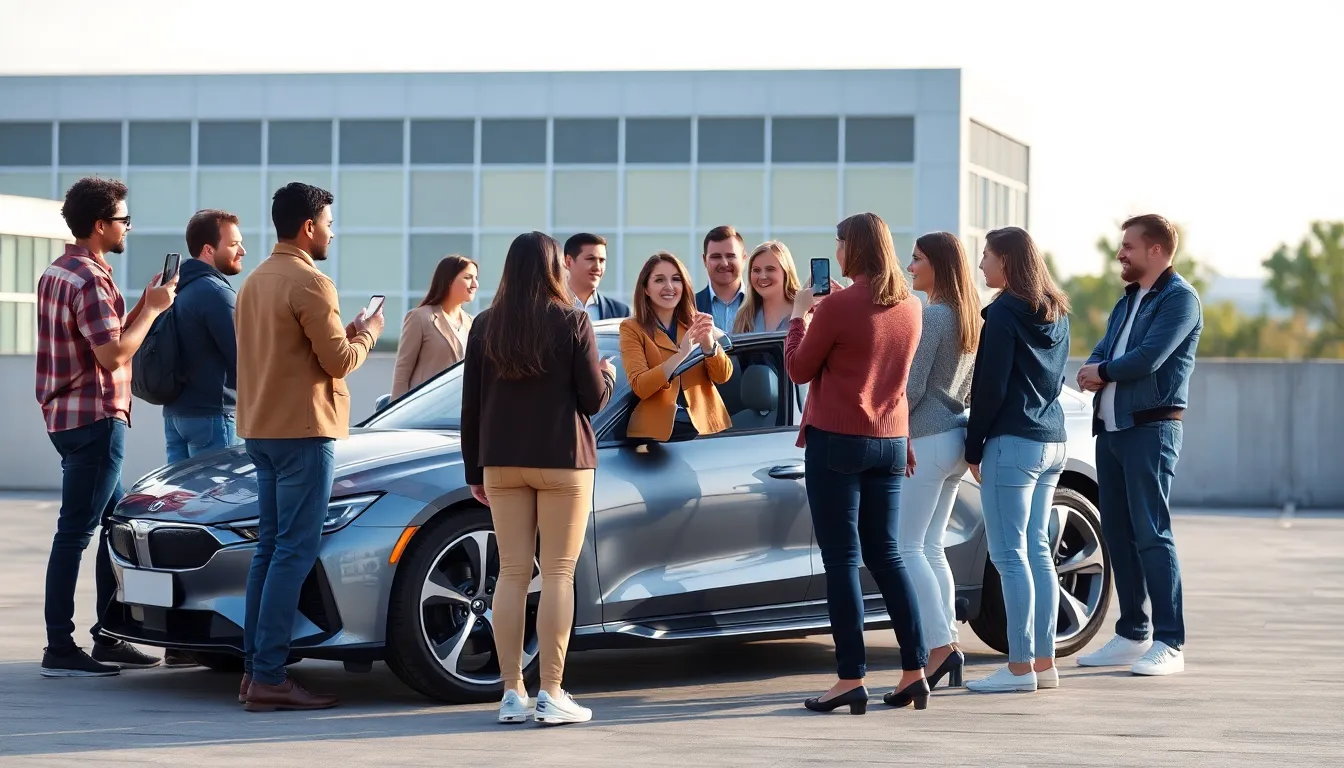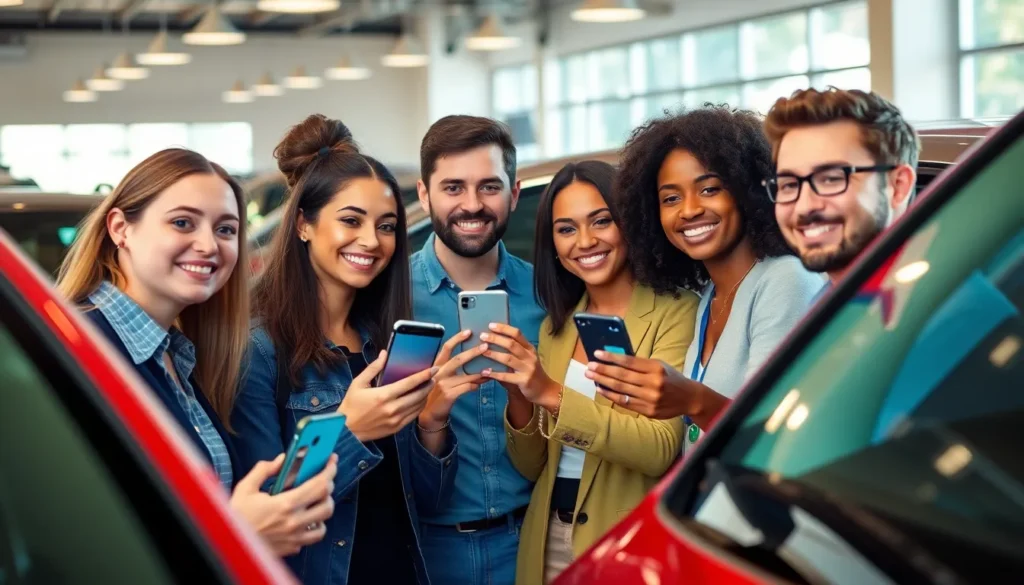In a world where everyone’s glued to their screens, automotive brands can’t afford to sit in the slow lane. Social media marketing isn’t just a trend; it’s the fuel that drives engagement and sales. With the right strategy, brands can shift gears and connect with potential customers in ways that traditional advertising simply can’t.
Table of Contents
ToggleUnderstanding Automotive Social Media Marketing
Automotive social media marketing leverages various platforms to connect brands with consumers. This strategy enhances customer engagement and drives sales in an increasingly digital marketplace.
Importance of Social Media in the Automotive Industry
Social media plays a crucial role in shaping consumer perceptions. Approximately 70% of car buyers research online before making purchases. Customers utilize platforms like Facebook, Instagram, and Twitter to seek reviews, compare models, and find promotions. Engaging content fosters brand loyalty, encouraging consumers to choose specific dealerships or manufacturers. Visual content, such as videos and images, significantly enhances the appeal of automotive brands, attracting attention in a crowded market.
Key Platforms for Automotive Marketing
Different platforms serve unique purposes in automotive marketing. Facebook offers targeted ads and community building, reaching various demographics effectively. Instagram captivates audiences through visual storytelling, a key aspect in showcasing vehicle features and lifetstyle alignment. Twitter excels in real-time engagement, ideal for sharing promotions and responding to customer inquiries. Additionally, YouTube serves as a powerful tool for product demonstrations and reviews, allowing consumers to see vehicles in action.
Strategies for Effective Automotive Social Media Marketing

Effective strategies enhance visibility and drive engagement within automotive social media marketing.
Content Creation and Engagement
Creative content captivates audiences, driving interaction and brand loyalty. High-quality images and videos showcase vehicles in compelling ways, making posts shareable. Engaging stories resonate with consumers, fostering emotional connections. Incorporating polls and questions invites participation, increasing interaction rates. Regular posting schedules maintain audience interest and ensure brands remain top of mind. Content variety, including tutorials or behind-the-scenes glimpses, keeps engagement fresh. Additionally, utilizing platform-specific features, like Instagram Stories or Facebook Live, maximizes reach and engagement. Notably, studies show that 85% of customers engage with content that entertains or informs, emphasizing the need for captivating materials.
Leveraging User-Generated Content
User-generated content strengthens trust and authenticity in automotive marketing. Engaging consumers to share their experiences encourages broader brand visibility. Featuring customer photos and testimonials not only personalizes the brand but also fosters community. Campaigns that incentivize users to create content increase participation, enhancing brand awareness. Recognizing and showcasing user content can lead to higher loyalty rates, as consumers feel valued when included. Social media contests and hashtag campaigns effectively drive user engagement. As evidence suggests, content created by consumers garners 50% more engagement than brand-generated content, highlighting its significance.
Measuring Success in Automotive Social Media
Assessing success in automotive social media requires careful consideration of specific metrics and tools. Brands need to identify what drives their engagement and revenue.
Key Performance Indicators (KPIs) to Track
Tracking key performance indicators helps determine the effectiveness of social media strategies. Engagement rate reflects how well content resonates with the audience, measuring likes, comments, and shares. Reach indicates how many users see posts, providing insight into overall visibility. Conversion rate tracks actual sales or leads generated from social media referrals. Furthermore, follower growth measures brand expansion and interest over time. Lastly, click-through rate evaluates the effectiveness of calls to action in driving traffic to websites.
Tools for Analyzing Social Media Performance
Analyzing social media performance relies on several effective tools. Google Analytics provides detailed insights into website traffic and user behavior linked to social media efforts. Hootsuite offers comprehensive dashboards for managing multiple platforms while tracking engagement metrics. Sprout Social stands out with robust reporting features, including demographics and performance comparisons. Buffer simplifies scheduling and provides analytics for post performance. Lastly, SEMrush assists in evaluating social media campaigns, allowing comparison with competitors to refine strategies.
Challenges in Automotive Social Media Marketing
Automotive brands face several challenges in social media marketing due to rapid changes in technology and consumer behavior. Navigating these platforms demands a deep understanding of diverse audience preferences. Creating relevant and engaging content consistently proves difficult, as trends shift quickly within the automotive sector.
Brand reputation management presents a significant challenge. Customers often voice concerns or criticize brands publicly, increasing the need for prompt and thoughtful responses. Responding effectively requires brands to maintain vigilance across all social media channels while fostering a positive community presence.
Moreover, competition intensifies as numerous automotive companies strive for attention on social media. Sifting through a crowded landscape, brands must identify unique selling points to stand out. Developing distinct messaging allows them to capture consumer interest amidst countless competing advertisements and promotions.
Data privacy regulations add complexity to social media strategies. With changes in legislation, managing user data securely while complying with requirements becomes essential. Each platform carries its own set of compliance rules, so automotive marketers must stay informed to avoid potential legal issues.
In addition, measuring the success of social media campaigns can pose challenges. Identifying the most relevant KPIs aligns with broader business goals, requiring insight into which metrics truly reflect customer engagement and interest. Building a comprehensive analytics strategy ensures informed decision-making based on performance data.
Lastly, keeping pace with technological advancements can be daunting. With evolving algorithms and tools, automotive brands must stay agile in adopting new approaches. Continually refining their strategies helps align with best practices and maximize engagement on platforms like Facebook, Instagram, and Twitter.
Future Trends in Automotive Social Media Marketing
Emerging technologies are reshaping automotive social media marketing. Artificial intelligence aids in personalizing customer experiences, allowing brands to deliver tailored content that resonates. Chatbots enhance customer service by providing instant responses to inquiries, streamlining communication across platforms.
Video content is gaining traction. With 80% of consumers preferring video over text, short-form videos on platforms like Instagram Reels and TikTok captivate audiences effectively. Live streaming becomes pivotal for product launches and Q&A sessions, fostering real-time interactions that build community.
User-generated content drives authenticity. Automotive brands increasingly encourage customers to share their experiences through photos and reviews. This strategy not only boosts engagement but also cultivates trust, as potential buyers view real-life experiences as credible.
Influencer partnerships remain crucial. Collaborating with automotive influencers extends reach to niche markets. Influencers create relatable content that connects with their followers, amplifying brand messaging and enhancing credibility.
Augmented reality is transforming the consumer journey. By integrating AR features, brands enable potential buyers to visualize vehicles in their own environments. Customers experience a more immersive buying process, bridging the gap between online and offline experiences.
Data privacy concerns shape strategies. Brands must prioritize transparency in data collection practices to foster consumer trust. Remaining compliant with privacy regulations protects customer information and enhances brand reputation.
Social listening tools are becoming essential. Monitoring brand mentions and consumer sentiment helps brands respond proactively to feedback. Engaging with customers based on insights gained from these tools strengthens relationships and informs content strategies.
Evolving algorithms on social media platforms necessitate agility. Adapting content strategies to align with shifts in platform behavior ensures consistent visibility. Brands that embrace change will maintain relevance and continue to engage effectively.
Automotive social media marketing is no longer optional; it’s a necessity for brands aiming to connect with today’s tech-savvy consumers. By leveraging the unique strengths of various platforms and focusing on engaging content, brands can significantly enhance their visibility and drive sales.
As the industry evolves, staying agile and responsive to trends will be crucial. Embracing new technologies and interactive content formats can create memorable experiences that resonate with potential buyers.
Ultimately, the brands that prioritize authentic engagement and adapt to the changing landscape will not only thrive but also build lasting relationships with their audiences.





